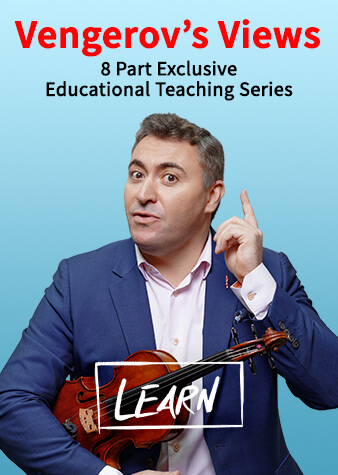New Review Addresses the Health Impact of Violin Playing
German researchers have released data collected from existing literature on the topic of musicians’ health, including those from 920 violinists
Titled “For Fiddlers on the Roof and in the Pit: Healthcare and Epidemiology of Playing-Related Problems in Violinists,” the 2023 review by German researchers and academics explores the long-term impacts of violin playing and how existing conditions may affect performance or predispose players to pain.
The review states that violinists, in particular, may experience pain or loss of function from technical issues, environmental factors, or insufficient guidance from teachers, parents, conductors, and medical professionals.
Today, orthopedists, neurologists, dentists/orthodontists, dermatologists, and audiologists are most commonly consulted by violinists in pain or discomfort.
In 2022, this study evaluated the existing published literature on musicians’ health, which revealed 2243 papers between 1948 and 2022. Out of these, the most relevant to the review were 30 papers involving cases of 6010 musicians and at least 920 violinists.
The authors of the review included Zahavah M. Zinn-Kirchner, Moonef Alotaibi, Dirk Mürbe, and Philipp P. Caffier.
Performing arts medicine was discussed as early as 1713, when Italian physician Bernardino Ramazzini wrote: “Workers in whom certain morbid affections gradually arise from some particular posture of the limbs or unnatural movements of the body called for while they work.” In other words, health conditions could potentially be caused by the inefficient use or positioning of the body.
A common challenge faced by violinists includes Playing-Related Musculoskeletal Disease (PRMD), where overtime, fine and deliberate movements necessary to produce clean and resonant sound, may lead to cramping, chronic conditions, or the loss of fine motor control.
However, in all studies covered by the review, players reported improved performance after taking more frequent breaks, mobility exercises, relaxation techniques, and positive student-teacher relationships.
Other prevention practices include the Alexander Technique, osteopathy, weather/temperature considerations, plus adequate rest being implemented into practice regimes and orchestral rehearsals; the use of ergonomic orchestral chairs could also “potentially solve many of the PRMD-related complaints violinists may experience.”
Another condition that may result from playing or overplaying is focal dystonia — a neurological condition that causes involuntary muscle contractions or spasms, which may cause cramps and tremors. Other neurological conditions included carpal tunnel syndrome, fingertip anesthesia, and bowing tremors.
To help those violinists experiencing pain, the review suggests introducing multi-disciplinary treatment specialists, including physiotherapists, osteopaths, and psychologists, as early as possible to prevent any long-term damage.
The diversification of treatments and their benefits are widely documented and may better support those who are unsure of the origin of their discomfort, or feel they have more than one condition affecting their playing.
More benefits include “better access to health information, shorter time from diagnosis to treatment, improved treatment and quality care, higher patient satisfaction, and better overall outcomes.”
Discussed less as a medical diagnosis, musical performance anxiety (MPA) can significantly affect a musician’s mindset. To overcome basal, self-imposed, and unphysiological strain, a healthy relationship can be built between one’s expectation of a sound, versus the output.
For orchestral musicians in the studies, pain increased due to pressure, over-practicing, comparison to others, and the inability to focus on the music. The review revealed that overall, players wished for more open discussions on such mental impacts.
Prevention tactics include the Freiburg Model — created by physicians at Germany’s University of Freiburg to help develop grounding practices for high-stress performance situations. Dismantling fear may include breaking it down into preparation, performance, and assessment.
Additionally, hearing loss may occur to varying degrees for violinists of different ages. The review states that hearing impairments could occur in the left ear, which is closest to the violin. To counter such impacts in an orchestral setting, selectively filtering earbuds in different frequency ranges could be implemented.
Players who started violin from a young age may display impacts in the development of the bones in their face, such as potential spinal impacts from a forward-leaning head position, and crossbites — resulting from the misalignment of the lower and upper jaw — leading to temporomandibular disorders (TMD).
Oral splints are suggested to alleviate misalignments in the jaw and prevent crossbites and manifestations of TMD. Other prevention measures may include fewer hours on the instrument — especially if misalignments are occurring.
In long practices, rehearsals, or performances, the contact and friction of the violin against the neck may result in lesions or “fiddler’s neck.” The review suggests dismantling the belief that lesions are symbols of diligent practice in order to achieve healthy working environments.
Further, it is posited that teachers prioritize finding chin and shoulder rests that best suit their students, and to test for allergens in the instrument and accessories should symptoms arise.
“Implementing warm-ups and other ergonomic habits, as well as educating all musicians on the importance of looking after their health, may be able to affect the necessary paradigm shift,” the review stated.
“To strengthen the health of string players, the education of all students in music physiology should be a fundamental part of their training, in addition to the prevention of playing-related diseases,” it continued. “Medical and paramedical professionals recognizing performing arts medicine as a form of occupational medicine are a crucial step toward developing the sensitivity to track epidemiological trends in this group, in order to better recognize and treat pathologies in the future.”
may 2024
june 2024































